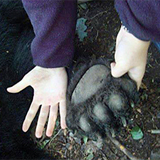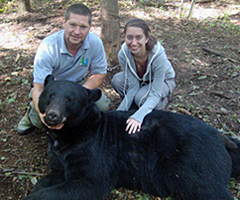Wildlife Ecology and Conservation Course Fall 2012
 For students interested in a career working with wildlife, Wildlife Ecology and Conservation is a must-take course. This class teaches students about animal behavior, population dynamics, and management strategies. Lecture topics include the evolution of migratory behavior, the causes of species extinctions, and case studies of management models.
For students interested in a career working with wildlife, Wildlife Ecology and Conservation is a must-take course. This class teaches students about animal behavior, population dynamics, and management strategies. Lecture topics include the evolution of migratory behavior, the causes of species extinctions, and case studies of management models.
The most appealing aspect of this class is each student's unique term project. Each student chooses a species native to New Jersey and is paired with a wildlife professional working on the management of that species. With his/her new mentor, each student then has an opportunity to experience "a day in the life of a wildlife professional" -- a hands-on experience that can involve a visit to a management site, or handling animals, including trapping, tagging, and releasing. Based on their experiences, students then design a mock management plan that is presented to the entire class at the end of the semester.
 Samantha Hauser (pictured right) studied bobcat management with Mick Valent from the NJ Endangered and Nongame Species Program. Although she was not lucky enough to see a bobcat in the wild, she helped to track a radio-collared male via VHF telemetry. Samantha explains the project as follows: "[NJ Endangered and Nongame Species Program and Rutgers] are basically using GIS to find the permeability of habitat for bobcats to see if they could potentially use corridors to help [their] dispersal throughout NJ." Students are encouraged to tag along on others' trips, so that everyone has a chance to interact with a wild animal. For example, Samantha accompanied classmate Eden Buenaventura on her black bear tagging trip with NJ Fish and Wildlife, during which they helped measure and collect data from tranquilized bears.
Samantha Hauser (pictured right) studied bobcat management with Mick Valent from the NJ Endangered and Nongame Species Program. Although she was not lucky enough to see a bobcat in the wild, she helped to track a radio-collared male via VHF telemetry. Samantha explains the project as follows: "[NJ Endangered and Nongame Species Program and Rutgers] are basically using GIS to find the permeability of habitat for bobcats to see if they could potentially use corridors to help [their] dispersal throughout NJ." Students are encouraged to tag along on others' trips, so that everyone has a chance to interact with a wild animal. For example, Samantha accompanied classmate Eden Buenaventura on her black bear tagging trip with NJ Fish and Wildlife, during which they helped measure and collect data from tranquilized bears.
 Kathleen Kerwin's (pictured left) species was the little brown bat. She accompanied Dr. Maslo, a bat conservationist herself, and John Gumbs from BATS Research Center to Hibernia Mine in Rockaway Township, one of the largest active bat hibernacula in New Jersey. Their mission was to screen the bats for the presence of Geomyces destructans (GD), the fungus responsible for White-Nose Syndrome (WNS), which has been decimating bat populations since 2006. They gently removed hibernating bats from the cave walls (Kathleen had previously been vaccinated for rabies, required for handling bats), and checked them for GD under white light, and also under UV light, under which the fungus fluoresces orange. They then banded the bats and carefully returned them to their roosting spot. "It was a really good experience to be able to get out of the classroom and laboratory, get hands-on experience, and also talk to wildlife experts," Kathleen says.
Kathleen Kerwin's (pictured left) species was the little brown bat. She accompanied Dr. Maslo, a bat conservationist herself, and John Gumbs from BATS Research Center to Hibernia Mine in Rockaway Township, one of the largest active bat hibernacula in New Jersey. Their mission was to screen the bats for the presence of Geomyces destructans (GD), the fungus responsible for White-Nose Syndrome (WNS), which has been decimating bat populations since 2006. They gently removed hibernating bats from the cave walls (Kathleen had previously been vaccinated for rabies, required for handling bats), and checked them for GD under white light, and also under UV light, under which the fungus fluoresces orange. They then banded the bats and carefully returned them to their roosting spot. "It was a really good experience to be able to get out of the classroom and laboratory, get hands-on experience, and also talk to wildlife experts," Kathleen says.
 The mastermind behind it all is Professor Maslo, who is teaching this course for the second time. In addition to teaching this class and Animal Behavior in the spring, Dr. Maslo conducts research and is involved in the conservation of piping plovers and native New Jersey bats. "I know how important it is to have connections with wildlife biologists in the field," she says. Her efforts to help her students one day become successful are evident in the planning and coordination of their projects. "Besides providing my students with a solid foundation of the principles of wildlife ecology, I hope to further impassion them to strive toward a wildlife-related career. To truly appreciate wildlife, one must experience it up close. Tagging tranquilized black bears or banding little brown bats are unparalleled experiences. And working beside a wildlife biologist gives my students a chance to develop professional relationships, seek internships, and receive honest advice about pursuing a career in this field."
The mastermind behind it all is Professor Maslo, who is teaching this course for the second time. In addition to teaching this class and Animal Behavior in the spring, Dr. Maslo conducts research and is involved in the conservation of piping plovers and native New Jersey bats. "I know how important it is to have connections with wildlife biologists in the field," she says. Her efforts to help her students one day become successful are evident in the planning and coordination of their projects. "Besides providing my students with a solid foundation of the principles of wildlife ecology, I hope to further impassion them to strive toward a wildlife-related career. To truly appreciate wildlife, one must experience it up close. Tagging tranquilized black bears or banding little brown bats are unparalleled experiences. And working beside a wildlife biologist gives my students a chance to develop professional relationships, seek internships, and receive honest advice about pursuing a career in this field."
Everyone is invited to attend this year's wildlife management presentations, which are held at the ENR building in Room 123 (preliminary schedule).
Story Contributed by Karen Leu.


